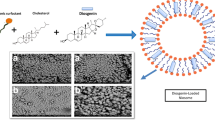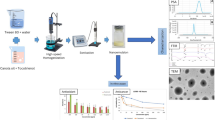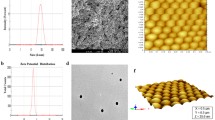Abstract
3,3′-Diindolylmethane (DIM) is a phytochemical that presents health benefits (antitumor, antioxidant, and anti-inflammatory effects). However, it is water insoluble and thermo- and photolabile, restraining its pharmaceutical applications. As a strategy to overcome such limitations, this study aimed the development and characterization of DIM-loaded nanocapsules (NCs) prepared with different compositions as well as the in vitro assessment of scavenging activity and cytotoxicity. The formulations were obtained using the interfacial deposition of preformed polymer method and were composed by Eudragit® RS100 or ethylcellulose as polymeric wall and primula or apricot oil as the core. All the formulations had adequate physicochemical characteristics: nanometric size (around 190 nm), low polydispersity index (< 0.2), pH value at acid range, high values of zeta potential, drug content, and encapsulation efficiency (~ 100%). Besides, nanoencapsulation protected DIM against UVC-induced degradation and increased the scavenging activity assessed by the 2,2′-azinobis-(3-ethylbenzothiazoline-6-sulfonic acid) and 1-1-diphenyl-2-picrylhydrazyl methods. The developed DIM-loaded nanocapsules were further evaluated regarding the in vitro release profile and cytotoxicity against a human glioblastoma cell line (U87 cells). The results demonstrated that the nanoencapsulation promoted a sustained release of the bioactive compound (in the range of 58–78% after 84 h) in comparison to its free form (86% after 12 h), as well as provided a superior cytotoxic effect against the U87 cells in the highest concentrations. Therefore, our results suggest that nanoencapsulation could be a promising approach to overcome the DIM physicochemical limitations and potentialize its biological properties.





Similar content being viewed by others
References
Banerjee S, Kong D, Wang Z, Bao B, Hillman GG, Sarkar FH. Attenuation of multi-targeted proliferation-linked signaling by 3,3′-diindolylmethane (DIM): from bench to clinic. Mutat Res. 2011;728(1–2):47–66. https://doi.org/10.1016/j.mrrev.2011.06.001.
Li Y, Kong D, Ahmad A, Bao B, Sarkar FH. Antioxidant function of isoflavone and 3,3′-diindolylmethane: are they important for cancer prevention and therapy? Antioxid Redox Signal. 2013;19(2):139–50 Available from: http://online.liebertpub.com/doi/abs/10.1089/ars.2013.5233.
Maruthanila VL, Poornima J, Mirunalini S. Attenuation of carcinogenesis and the mechanism underlying by the influence of indole-3-carbinol and its metabolite 3,3???-diindolylmethane: a therapeutic marvel. Adv Pharmacol Sci. 2014;2014.
Kim EJ, Park H, Kim J, Park JHY. 3,3′-Diindolylmethane suppresses 12-O-tetradecanoylphorbol-13- acetate-induced inflammation and tumor promotion in mouse skin via the downregulation of inflammatory mediators. Mol Carcinog. 2010;49(7):672–83.
Roy S, Mandal M, Pal C, Giri P, Kumar GS, Mukherjee J, et al. Studies on aqueous solubility of 3,3′-diindolylmethane derivatives using cyclodextrin inclusion complexes. J Mol Struct. 2013;1036:1–6.
Vallejo F, Tomás-Barberán FA, Garcia-Viguera C. Glucosinolates and vitamin C content in edible parts of broccoli florets after domestic cooking. Eur Food Res Technol. 2002;215(4):310–6.
Wu T, Huang Y, Zhang C. Pharmacokinetics and pharmacodynamics of 3 , 3 0 -diindolylmethane ( DIM ) in regulating gene expression of phase II drug metabolizing enzymes. J Pharmacokinet Pharmacodyn. 2015;42(4):401–8.
Mora-Huertas CE, Fessi H, Elaissari A. Polymer-based nanocapsules for drug delivery. Int J Pharm. 2010;385(1–2):113–42.
Nicolas J, Mura S, Brambilla D, MacKiewicz N, Couvreur P. Design, functionalization strategies and biomedical applications of targeted biodegradable/biocompatible polymer-based nanocarriers for drug delivery. Chem Soc Rev. 2013;42:1147–235.
Dimer FA, Friedrich RB, Beck RCR, Guterres SS, Pohlmann AR. Impact of nanotechnology on public health: production of medicines. Quim Nova. 2013;36(10):1520–6.
Bhokare SG, Marathe RP, Gaikwad MT, Salunke PB. Biodegradable polymer based nanoparticles: a novel approach. Int J Pharm Sci Rev Res. 2015;35(1):43–52 Available from: https://www.scopus.com/inward/record.uri?eid=2-s2.0-84949635537&partnerID=40&md5=038578252a233be9c5e020874bec2613.
Frank LA, Contri RV, Beck RCR, Pohlmann AR, Guterres SS. Improving drug biological effects by encapsulation into polymeric nanocapsules. Wiley Interdiscip Rev Nanomed Nanobiotechnol. 2015;7(5):623–39.
Santos SS, Lorenzoni A, Pegoraro NS, Denardi LB, Alves SH, Schaffazick SR, et al. Formulation and in vitro evaluation of coconut oil-core cationic nanocapsules intended for vaginal delivery of clotrimazole. Colloids Surf B: Biointerfaces. 2014;116:270–6. https://doi.org/10.1016/j.colsurfb.2014.01.011.
Gehrcke M, Giuliani LM, Ferreira LM, Barbieri AV, Sari MHM, da Silveira EF, et al. Enhanced photostability, radical scavenging and antitumor activity of indole-3-carbinol-loaded rose hip oil nanocapsules. Mater Sci Eng C. 2017;74:279–86. https://doi.org/10.1016/j.msec.2016.12.006.
Marchiori MCL, Rigon C, Copetti PM, Sagrillo MR, Cruz L. Nanoencapsulation improves scavenging capacity and decreases cytotoxicity of silibinin and pomegranate oil association. AAPS PharmSciTech. 2017;18(8):3236–46 Available from: http://link.springer.com/10.1208/s12249-017-0810-5.
Sayanova O, Napier JA, Shewry PR. Δ6-Unsaturated fatty acids in species and tissues of the Primulaceae. Phytochemistry. 1999;52(3):419–22.
Femenia A, Rossell C, Mulet A, Caiiellas J. Chemical composition of bitter and sweet apricot kernels. J Agric Food Chem. 1995;(1978):356–61.
E-aal MHA, Khalil MKM, Rahma EH. Apricot kernel oil : characterization , chemical composition and utilization in some baked products. Food Chem. 1986;19:287–98.
Paltsev M, Kiselev V, Muyzhnek E, Drukh V, Kuznetsov I, Pchelintseva O. Comparative preclinical pharmacokinetics study of 3,3′-diindolylmethane formulations: is personalized treatment and targeted chemoprevention in the horizon? EPMA J. 2013;4:25 Available from: http://www.pubmedcentral.nih.gov/articlerender.fcgi?artid=4029298&tool=pmcentrez&rendertype=abstract.
Luo Y, Wang TTY, Teng Z, Chen P, Sun J, Wang Q. Encapsulation of indole-3-carbinol and 3,3'-diindolylmethane in zein/carboxymethyl chitosan nanoparticles with controlled release property and improved stability. Food Chem. 2013;139(1–4):224–30. https://doi.org/10.1016/j.foodchem.2013.01.113.
Isabella S, Mirunalini S. Chemotherapeutic effect of 3, 3′-diindolylmethane encapsulated chitosan nanoparticles on 7, 12-dimethylbenz (a) anthracene induced mammary cancer - a dose dependent study. 2016;3(1):1–8.
Isabella S, Mirunalini S. Protective effect of 3, 3′-diindolylmethane encapsulated chitosan nanoparticles prop up with lipid metabolism and biotransformation enzymes against possible mammary cancer. J Appl Pharm Sci. 2017;7(3):194–201.
Bhowmik A, Chakravarti S, Ghosh A, Shaw R, Bhandary S, Bhattacharyya S, et al. Anti-SSTR2 peptide based targeted delivery of potent PLGA encapsulated 3,3′-diindolylmethane nanoparticles through blood brain barrier prevents glioma progression. Oncotarget. 2017;8(39):65339–58.
Fessi H, Puisieux F, Devissaguet JP, Ammoury N, Benita S. Nanocapsule formation by interfacial polymer deposition following solvent displacement. Int J Pharm. 1989 [cited 2016 Jul 30];55(1):R1–4. Available from: http://linkinghub.elsevier.com/retrieve/pii/0378517389902810
Re R, Pellegrini N, Proteggente A, Pannala A, Min Yang A, Catherine R-E. Antioxidant activity appliying an improved ABTS radical. Free Radic Biol Med. 1999;26(9/10):1231–7.
Sharma OP, Bhat TK. DPPH antioxidant assay revisited. Food Chem. 2009;113:1202–5.
Korsmqer RW, Gumy R, Doelker E, Buri P, Peppas NA. Mechanisms of solute release from porous hydrophilic polymers. 1983;15:25–35.
Guterres SS, Weiss V, De Lucca Freitas L, Pohlmann AR. Influence of benzyl benzoate as oil core on the physicochemical properties of spray-dried powders from polymeric nanocapsules containing indomethacin. Drug Deliv. 2000 [cited 2016 Aug 1];7(4):195–9. Available from: http://www.tandfonline.com/doi/full/10.1080/107175400455119.
Santos SS, Lorenzoni A, Ferreira LM, Mattiazzi J, Adams AIH, Denardi LB, et al. Clotrimazole-loaded Eudragit® RS100 nanocapsules: preparation, characterization and in vitro evaluation of antifungal activity against Candida species. Mater Sci Eng C. 2013;33(3).
Gehrcke M, Sari MHM, Ferreira LM, Barbieri AV, Giuliani LM, Prado VC, et al. Nanocapsules improve indole-3-carbinol photostability and prolong its antinociceptive action in acute pain animal models. Eur J Pharm Sci. 2018;111(May 2017):133–41. https://doi.org/10.1016/j.ejps.2017.09.050.
Pegoraro NS, Mattiazzi J, da Silveira EF, Azambuja JH, Braganhol E, Cruz L. Improved photostability and cytotoxic effect of coenzyme Q10 by its association with vitamin E acetate in polymeric nanocapsules. Pharm Dev Technol. 2017:1–19 Available from: https://www.tandfonline.com/doi/full/10.1080/10837450.2017.1332641.
Pegoraro NS, Barbieri AV, Camponogara C, Mattiazzi J, Brum ES, Marchiori MCL, et al. Nanoencapsulation of coenzyme Q10 and vitamin E acetate protects against UVB radiation-induced skin injury in mice. Colloids Surf B: Biointerfaces. 2017;150:32–40.
Rigon C, Giuliani LM, Fabiele M, Stangarlin L, Mattiazzi J, Gomes FP, et al. Sistemas nanoestruturados contendo óleo de linhaça: desenvolvimento tecnológico e caracterização físico-química de nanoemulsões e nanocápsulas poliméricas. Saúde (Santa Maria). 2017;43(1):153–61.
dos Santos PP, Flôres SH, de Oliveira Rios A, Chisté RC. Biodegradable polymers as wall materials to the synthesis of bioactive compound nanocapsules. Trends Food Sci Technol. 2016;53:23–33.
Mohanraj VJ, Chen Y. Nanoparticles – a review. Trop J Pharm Res. 2006;5(June):561–73.
Schaffazick SR, Pohlmann AR, Mezzaliraa G, Guterres SS. Development of nanocapsule suspensions and nanocapsule spray-dried powders containing melatonin. J Braz Chem Soc. 2006;17(3):562–9.
Boakye CHA, Patel K, Doddapaneni R, Bagde A, Chowdhury N, Safe S, et al. Ultra-flexible nanocarriers for enhanced topical delivery of a highly lipophilic antioxidative molecule for skin cancer chemoprevention. Colloids Surf B: Biointerfaces. 2016;143:156–67. https://doi.org/10.1016/j.colsurfb.2016.03.036.
Ourique AF, Pohlmann AR, Guterres SS, Beck RCR. Tretinoin-loaded nanocapsules: preparation, physicochemical characterization, and photostability study. Int J Pharm. 2008;352:1–2):1–4.
Detoni CB, Souto GD, Da Silva ALM, Pohlmann AR, Guterres SS. Photostability and skin penetration of different E-resveratrol-loaded supramolecular structures. Photochem Photobiol. 2012;88(4):913–21.
Shalaby EA, Shanab SMM. Comparison of DPPH and ABTS assays for determining antioxidant potential of water and methanol extracts of Spirulina platensis. Indian J Mar Sci. 2013;42(September):556–64.
Miliauskas G, Venskutonis PR, Van Beek TA. Screening of radical scavenging activity of some medicinal and aromatic plant extracts. Food Chem. 2004;85(2):231–7.
Alves CQ, David JM, David JP, Bahia MV, Aguiar RM. Métodos para determinação de atividade antioxidante in vitro em substratos orgânicos. Quím Nova. 2010;33(10):2202–10.
Benabadji SH, Wen R, Zheng J, Dong X, Yuan S. Anticarcinogenic and antioxidant activity of diindolylmethane derivatives. Acta Pharmacol Sin. 2004;25(5):666–71 Available from: http://www.ncbi.nlm.nih.gov/pubmed/15132835.
Li F, Jin H, Xiao J, Yin X, Liu X, Li D, et al. The simultaneous loading of catechin and quercetin on chitosan-based nanoparticles as effective antioxidant and antibacterial agent. Food Res Int. 2018;111(May):351–60. https://doi.org/10.1016/j.foodres.2018.05.038.
Kosaraju SL, D’ath L, Lawrence A. Preparation and characterisation of chitosan microspheres for antioxidant delivery. Carbohydr Polym. 2006;64(2):163–7.
Chassot JM, Ribas D, Silveira EF, Grünspan LD, Pires CC, Farago PV, et al. Beclomethasone dipropionate-loaded polymeric nanocapsules: development, in vitro cytotoxicity and in vivo evaluation of acute lung injury. J Nanosci Nanotechnol. 2015;15:855–64.
Anuchapreeda, S., et al. Preparation of Lipid Nanoemulsions Incorporating Curcumin for Cancer Therapy. Journal of Nanotechnology. 2012;1.
Liang, N. et al. ALFA-Tocopherol succinate-modified chitosan as a micellar delivery system for paclitaxel: Preparation, characterization and in vitro/in vivo evaluations. International Journal of Pharmaceutics. 2012;423:480– 488.
Schultze, E., et al. Drug-loaded nanoemulsion as positive control is an alternative to DMSO solutions for in vitro evaluation of curcumin delivery to MCF-7 cells. Pharmacological Reports. 2017;1408–1412.
Chittasupho, C. et al. Nanoparticles of Combretum quadrangulare leaf extract induce cytotoxicity, apoptosis, cell cycle arrest and anti-migration in lung cancer cells. Jornal of drug delivery science and technology. 2018;45:378.
Li, Y., et al. Emulsion-Based Delivery Systems for Tributyrin, a Potential Colon Cancer Preventative Agent. J Agric Food Chem. 2009;57:9243–9249.
Mendes, L.P., et al. Biodegradable nanoparticles designed for drug delivery: The number of nanoparticles impacts on cytotoxicity. Toxicology in Vitro. 2015;29:1268–1274.
Krai, J., et al. Doxazosin nanoencapsulation improves its in vitro antiproliferative and anticlonogenic effects on breast cancer cells. Biomedicine & Pharmacotherapy. 2017;94:10–20.
Rocha, V., et al. In vitro cytotoxicity evaluation of resveratrol-loaded nanoparticles: Focus on the challenges of in vitro methodologies. Food and Chemical Toxicology. 2017;103:214-222.
Sari MHM, Ferreira LM, AngonesiZborowski V, Araujo PCO, Nadal JM, Farago PV. p,p’-Methoxyl-diphenyl diselenideincorporation into polymeric nanocapsules improves its antinociceptive action: physicochemical and behavioral studies. Colloids Surf B: Biointerfaces. 2017;157(et al):464–72. https://doi.org/10.1016/j.colsurfb.2017.06.016.
Author information
Authors and Affiliations
Corresponding author
Additional information
Publisher’s note
Springer Nature remains neutral with regard to jurisdictional claims in published maps and institutional affiliations.
Rights and permissions
About this article
Cite this article
Mattiazzi, J., Sari, M.H.M., Lautenchleger, R. et al. Incorporation of 3,3′-Diindolylmethane into Nanocapsules Improves Its Photostability, Radical Scavenging Capacity, and Cytotoxicity Against Glioma Cells. AAPS PharmSciTech 20, 49 (2019). https://doi.org/10.1208/s12249-018-1240-8
Received:
Accepted:
Published:
DOI: https://doi.org/10.1208/s12249-018-1240-8




